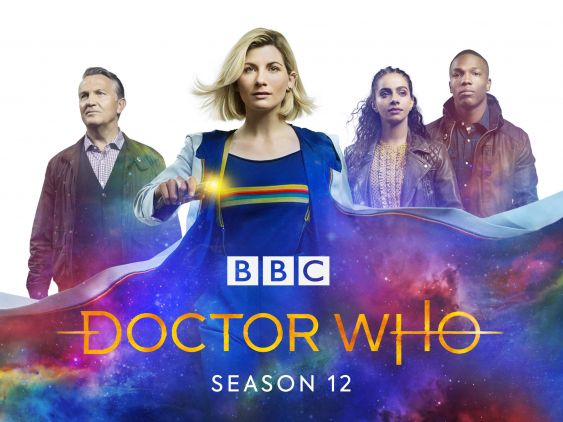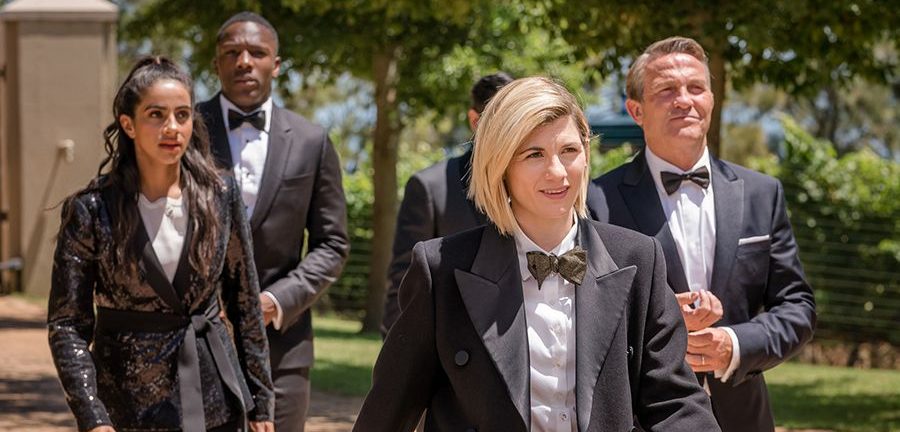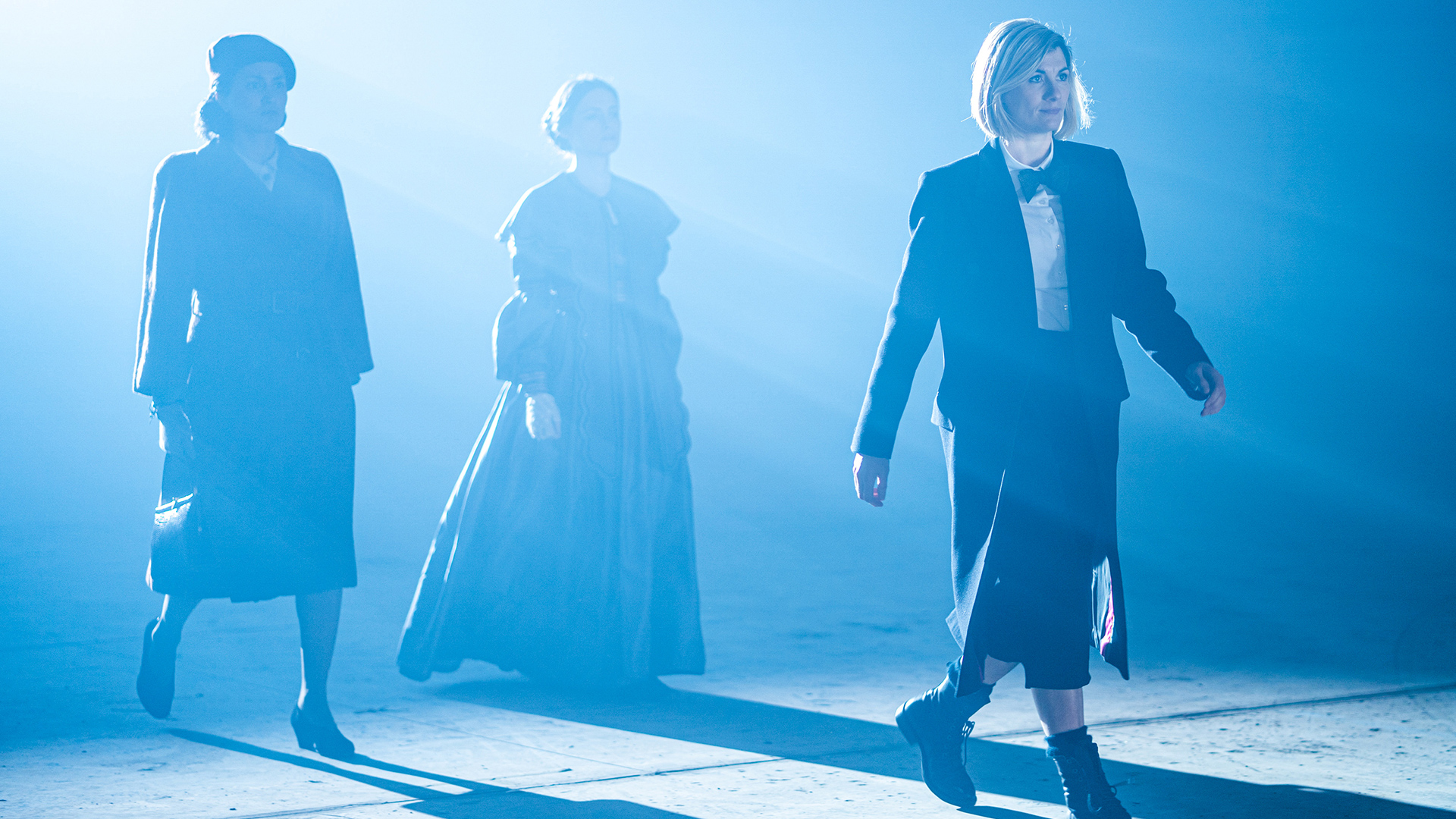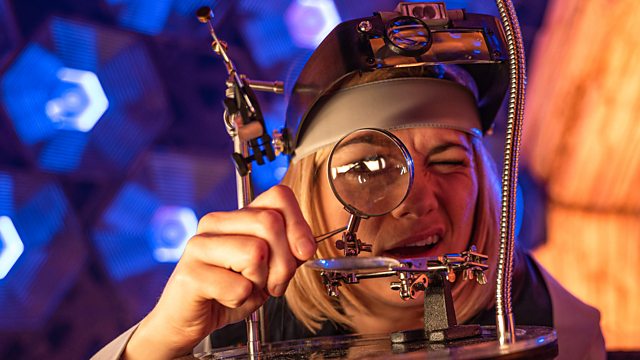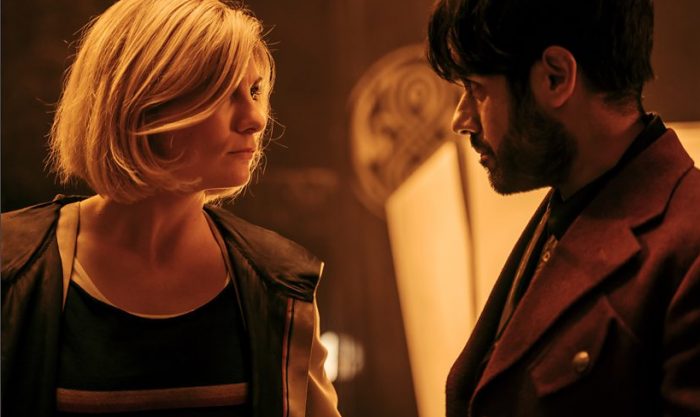The Doctor is back. Jodie Whittaker returns as the Time Lord with Chris Chibnall back as showrunner for their second year with the series. Also returning are her three companions: Ryan Sinclair (Tosin Cole), Graham O’Brien (Bradley Walsh), and Yasmin Khan (Mandip Gill). Last season was notable for having the first female Doctor, a new showrunner, and a switch to stand-alone episodes. Thought that was a big shake up? The latest season, or series, really changes things. Some of these changes are returns to previous traditions in the show, with classic monsters such as the Cybermen returning to the program. Notably, last season didn’t feature any classic monsters or villains, likely to make it a bit easier for newcomers to join in without feeling like they had to catch up on too much lore. In hindsight, this new season does not make it easy for new time viewers, but all the more reason to check out the last one.
It’s hard to talk about this season without major spoilers, so I’ll go into a spoiler-free breakdown here and then start talking tearing the lid of things once we get to the individual episodes reviews themselves.
In keeping things vague, I will say that this season has the biggest twist of the whole contemporary version of Doctor Who. The show famously ended in 1989 and then came back in 2005 in what is referred to by fans as “New Who.” Fans of the new iteration will likely remember the 50th anniversary special back in 2013 (Side note, that was the first episode I ever saw, and it hooked me into watching). The special provided the revelation that the Doctor’s home planet of Gallifrey had actually not gotten destroyed in the Time War but rather moved to a different dimension in order to protect itself. At the time, this was the biggest twist of the show, as previous episodes all dealt with the Doctor’s displacement from the planet. In 2020, we’re only three years away from the 60th anniversary, yet it appears the show has decided to bring a big twist a bit early, for better or for worse. But this isn’t the only twist the show makes. In fact, this season is full of them. Let’s dive in, and at this point it goes without saying, “Spoilers!”
Spyfall, Part 1
“The name’s Doctor. The Doctor.” The Doctor and fam make their return, and this time they’re spies. The new episode, entitled “Spyfall, Part 1,” is a none too subtle pastiche of the James Bond movies. Not that that’s a bad thing, necessarily. It starts off with an intriguing prologue in which spies from around the world get taken out by spectral entities that come out of the walls. We then catch up with our heroes as MI6, let by a wonderfully wry Stephen Fry, takes them in to get their advice. Clues lead them to a former agent in Australia played by Sacha Dawan, as well as the CEO of a Google-like corporation played by Lenny Henry. Interestingly, Henry previously played the Doctor in a sketch comedy show of his, but is frustratingly non-comedic in this role.
The episode has high production value, at least for Doctor Who standards, such as two thrilling chases bookending the plot. Unfortunately, the story in between proves repetitive and dull, as characters continuously have to evade various bad guys, human and otherwise. It doesn’t make much sense either, as many different threads get thrown out but it’s never really clear how or why they’re related. Much talk is made of the various gadgets spies use, but we rarely see them in action. As the concept of Chekhov’s Gun dictates, if you show something off in the first act, it should get used in the second.
Now it’s worth noting that this episode is a two-parter, the first one attempted by Chris Chibnall since he took over as showrunner. It features a great final sequence and a twist that will catch many fans off-guard, but doesn’t quite stand on its own. “Spyfall, Part 1″ has a few small things going for it, including creepy aliens, solid humor, and a great soundtrack that sounds straight out of a Bond flick by composer Segun Akinola.
Spyfall, Part 2
“Spyfall, Part 2” picks up where “Spyfall, Part 1” left us. Ryan, Graham, and Yaz are onboard a plane taking a bit of a nosedive thanks to a bomb on board. The Doctor has just found out that Gallifrey has been burnt to the ground. And who did this? Well, I didn’t want to quite spoil the twist at the end of the first part, but it turns out that the former agent played by Sacha Dawan is actually The Master. No explanation is made of how The Master survived their supposed final form from the Capaldi era or if this is an earlier regeneration. Regardless, they pursue The Doctor through various eras, where The Doctor teams up with mathematician Ada Lovelace in the 1830s and British spy Noor Inayat Khan in the 1940s. Together they team up to thwart the Master across time and get back to the present to stop the plan of the tech mogul played by Lenny Henry.
While the first part puts everything into place, the second part serves up the pay-off. The spy devices finally get used, notably the laser-firing shoes in a wonderful sequence in which Graham figures out how to work them, more or less, by accident. The episode also gets to show off the sets of the show, which are often a high point, as it travels from a falling plane to a 19th century exhibition to Nazi-occupied France to the present. The downside of this is that the episode doesn’t quite have enough room to breathe, and the revelation that Gallifrey is once again destroyed doesn’t hit as hard as it should.
While a few plot points get thrown by the wayside, the episode shines in everything it is able to cram in. Whenever a new Master arrives, similar to a new Doctor, there’s always a new personality to be explored. Sacha Dawan seems to be having a blast in the role, dialing into the rage of the character but nevertheless providing a tinge of grief to it. Since Whittaker’s Doctor last season had a somewhat happy-go-lucky attitude towards their adventures, it’s fascinating to see this relationship bring out the more calculating side of her.
Orphan 55
On the heel of the surprise-filled episodes of “Spyfall” comes “Orphan 55,” a standard one-off episode in which the Doctor and fam take a much-needed trip to a spa for a vacation. Or so they intend. Naturally, monsters break into the spa and attack the guests, and our heroes have to figure out how to stop them. In doing so, they find out that the spa is actually an enclave built on an otherwise uninhabitable planet, or orphan planet. The Doctor and companions and the few survivors of the attack decide to venture out of the spa in the hopes of bringing back a captured vacationer and finding out the mystery of who these creatures are and how they got in.
Like many of the episodes under Chris Chibnall’s leadership of the show, “Orphan 55” satirizes corporations and attractions. Yet the twist ending comes off as predictable and abrupt. With the events of the last two episodes fresh on the characters’ minds, this adventure feels tacked-on, like the writers needed another episode but weren’t quite sure what to do, relying on the traditional format of The Doctor visiting a seemingly peaceful planet and finding danger. There seem to be nods to the 2008 episode “Midnight,” yet this one fails to reach its emotional highs. All that being said, Doctor Who originally debuted as an educational children’s program, and this episode does tap into those roots.
Nikola Tesla’s Night of Terror
As its title suggest, “Nikola Tesla’s Night of Terror” provides an in-depth look at a historical figure, or in this case, two. Goran Visnjic provides real warmth as Tesla, juxtaposed with Robert Glenister’s businesslike Thomas Edison. The story begins at Niagara Falls in 1903, with Tesla looking for investors. After him and his assistant Dorothy Skerrit, played by a supportive Haley McGee, get attacked by a cloak figure, they make a daring escape by train with the help of the Doctor. Arriving in New York, they come face to face with Tesla’s competitor, Thomas Edison. After that, all the assembled characters, scientist or otherwise, come face to face with hostile aliens, and have to work together to protect Earth.
Some of the best Doctor Who episodes are those that recontextualize famous historical events and figures, and this one is no exception. Many may have heard of the feud between Tesla and Edison, which the latter arguably won through his success. Yet the episode portrays the nuance of this relationship, which is similar in some ways to that of the Doctor and the Master. They may hate each other, but there’s begrudging respect. The episode also takes a hard look at what it means to prioritize beliefs over fame.
Aside from the deep thematic elements of the episode, it’s also a lot of fun. There are a few great action sequences, notably the train escape and a dash through the streets of turn-of-the-century New York with laser-firing robot-scorpions in pursuit. The strong actions elements and set pieces fitting neatly alongside nuanced discussions around the value systems people hold help to elevate this episode to one of the season’s best.
Fugitive of the Judoon
Unlike last season, Chibnall aims to provide this one with more of a through-line. If this is the case, “Fugitive of the Judoon” is the midpoint of that narrative. That being said, the episode starts off disarmingly simple. The Doctor learns that a platoon of Judoon have descended on Earth (near that lagoon!) which has happened before. As always, the Judoon are searching for a fugitive, who seems to have some sort of relation to a tour guide played by Jo Martin. So far, simple stuff. Yet several big reveals take place in short succession. Graham is kidnapped by a spaceship, piloted by none other than Captain Jack Harkness himself, who mistakes Graham for the Doctor. Meanwhile, the lockbox of the tour guide turns out to be a Chameleon Arc, meaning that the tour guide is actually a Time Lord. Not just any Time Lord, the Doctor! The Doctor? But how?
First, let’s talk about the two notable cast members. Jo Martin makes her debut as the Doctor, and one of the most interesting things about this is her take on the character. This Doctor is a bit more jaded than previous iterations (even Capaldi’s) and seems unafraid to use force when necessary. Even though we see her as The Doctor herself for a brief time, she’s able to convey a history that separates her from our current iteration. Next we have John Barrowman, whose return is not to be understated as it marks the end of a hiatus that lasted over ten years.
But on the flip side, these appearances don’t reach their potential. Martin’s Doctor leaves without any explanation, leaving the audience to wonder about her. It seems like she isn’t the next Doctor, but rather exists as a plot device rather than a fully formed character, which is a shame because Martin’s acting conveys a lot with a little. Likewise, Barrowman’s appearance is brief, and while it’s a blast to see him trying to find the Doctor while fending off attackers, he doesn’t actually get to interact with either of the Doctors at all. The episode gets a lot out of the appearance of these characters, but doesn’t seem to know what to do with them exactly.
Praxeus
With “Praxeus” the show takes another break from the story arc for another romp across various locales. Instead of time, the episode focuses more on space, with each member of Team TARDIS investigating strange phenomena in various locations around the globe. What do a disappearing astronaut, a dying US naval officer, and a bunch of birds acting strangely have to do with each other? Three stories play out simultaneously before getting linked together in a larger mystery.
Admittedly, the mystery itself isn’t as interesting as its premise. There’s a large cast of characters with various motivations and the show struggles to balance all of them. That being said, there’s a sweet subplot between the astronaut and his husband, which does have a nice payoff to it. Like “Orphan 55,” there’s another educational message this time around, which feels a bit shoe-horned in but nevertheless does have a basis in reality.
Can You Hear Me?
Arguably one of the best episode of New Who is “Vincent and the Doctor” due to how the show delicately and earnestly portrayed mental health issues. In “Can You Hear Me?” Doctor Who attempts to tackle the subject matter of mental illness again. The Doctor gets an alert from a mental hospital in 14th century Syria. Arriving just in time to find the hospital’s last surviving patient, The Doctor teams up with her to get to the bottom of things. Meanwhile, her companions stay behind in present-day Sheffield, and have encounters with a creepy man who can detach his fingers and make them float into people’s ears at night. Unsettling stuff.
Overall, “Can You Hear Me?” handles the themes around mental health moderately well, with some missteps. The trip to 14th century Syria feels like a missed opportunity to actually explore the mental health culture of the time, and seems to exist more for brownie points. Towards the end, Graham opens up to the Doctor about his own health issues, and the Doctor gives an uncharacteristically evasive response. That being said, the episode does allow for meaningful exploration into the interior lives of the three companions, something that often went by the wayside in the previous season.
The Haunting of Villa Diodati
One of the highlights of Doctor Who is seeing how the science-fiction elements of the show end up influencing the real-life historical events that the show portrays in its cannon. When The Doctor and friends show up unannounced at the retreat of Mary Shelley on the night of her writing Frankenstein, they fully expect to experience the first telling of the famous gothic horror novel. Played by Lili Miller, Mary Godwin (not yet married to Percy Shelley) seems more interested dancing and partying with Lord Byron, Percy Shelley and her other friends than writing a novel. That is, until a Cyberman shows up, marking the first appearance of the classic villainous race since Capaldi’s final season.
The best horror movies succeed at making one single entity scary, and this episode is no exception. The show has portrayed Cybermen invasions many times, yet the appearance of one lone one is downright chilling. Director Emma Sullivan draws on the gothic atmosphere in having the Cyberman prowl the house searching for its occupants. The writing of Maxine Alderton bolsters that, combining Shelley lore with Doctor Who mythos in a satisfying fashion.
Aside from providing another great look at a historical event, the episode also advances the plot of the season by its end. The Doctor is forced to make a difficult decision, one which sets off much of what comes before and after in the story arc. In doing so, we get to see The Doctor at the core of who she is, as so many of the tough decisions the character has made over the years have provided glimpses into their personalities.
Ascension of the Cybermen
With the closing events of the last episode kicking the overarching plot into high-gear, “Ascension of the Cybermen” returns to the story brought up in the beginning and mid-season episodes. Why is the Master back? Why is there another Doctor? The episode begins in turn of the century Ireland, with a childless couple discovering an abandoned baby. As the baby grows up into an adult, he has a run-in with death but miraculously comes back to life. This peculiar subplot is cut off by a more traditional one, as the Doctor and the companions help attempt to save the few remaining humans from the Cybermen. The situation looks dire, but they believe they can find a way to a portal that’ll take them to a random planet in the galaxy, thereby allowing them to escape.
While the “last remaining members of humanity” proves to be a dire predicament indeed, it’s undercut by the knowledge that this scenario has played out several times before, with humanity at the brink of extinction and some quick-thinking on the part of the Doctor allowing it to bounce back. As such, the stakes feel lower than they should. The Ireland subplot is the strong point of the episode, but it unfortunately takes a back seat upon getting interrupted.
The end of the episode does put the narrative back on track, as a few plot points fall into place, setting the stage for the finale. Ian McElhinney appears as a sort of wise guardian character, tasked with protecting the portal that will allow humanity, or what’s left of it, to escape.
The Timeless Children
And now, the grand finale. If you’ve avoided the major twists of this season for this long, all the stops come out here. Upon arriving at the portal, The Doctor and the remnants of humanity are greeted by two surprises: The Master and the remnants of Gallifrey. While the portal could lead to any planet, The Master has ensured that they’ll go right into the Time Lords’ home world. Here, he reveals to The Doctor the truth around “the timeless child.” The Doctor was actually the very first Time Lord, discovered by the inhabitants of Gallifrey who studied her regeneration powers in order to replicate them for themselves. After the studies were complete, they wiped The Doctor’s mind, thereby creating the iteration of The Doctor that we know through the series. This solves the mysteries surrounding the man in Ireland and Jo Martin’s Doctor, as both were The Doctor before The Doctor became The Doctor. Make sense?
Now, the answer to that question may vary from viewer to viewer, as will how one feels about this revelation. In essence, there have been many Doctors before the ones depicted in the show. Is this twist a good or a bad one? Well, it’s hard to say. As of now, it’s more of a confusing one. Whereas the major twist of the 50th anniversary special allowed the show to clearly incorporate Gallifrey into the narrative, this change seems to be more of a head-scratcher. Does it allow more people to play the Doctor? Yes, although the show already had actors taking up the mantle from each other. In this case, it seems that it allows the show to have stars play The Doctor in one-off appearances, such as Jo Martin. As a season finale, it shakes things up, but it doesn’t quite have the payoff that previous events seemed to lead up to.
Summary
Change is never easy, not the least for a show that has existed for over 55 years. The latest season of Doctor Who shakes things up, proving itself the season of twists. Almost every episode contains a revelation, whether it’s a returning character, a major plot development, or a piece of information that completely recontextualizes the lore of the show. Overall, this season marks a step down from the previous one, although it deserves points for trying to inject new life into a tried-and-true formula. The plot twists put forth in this season seem to hint at future developments, as many of them exist merely to shake things up but don’t have ramifications that get explored. What will they signify for the future of Doctor Who going forward? Well, only time will tell.
-
Doctor Who Series 12
-
Spyfall, Part 1
-
Spyfall, Part 2
-
Orphan 55
-
Nikola Tesla's Night of Terror
-
Fugitive of the Judoon
-
Praxeus
-
Can You Hear Me?
-
The Haunting of Villa Diodati
-
Ascension of the Cybermen
-
The Timeless Children


